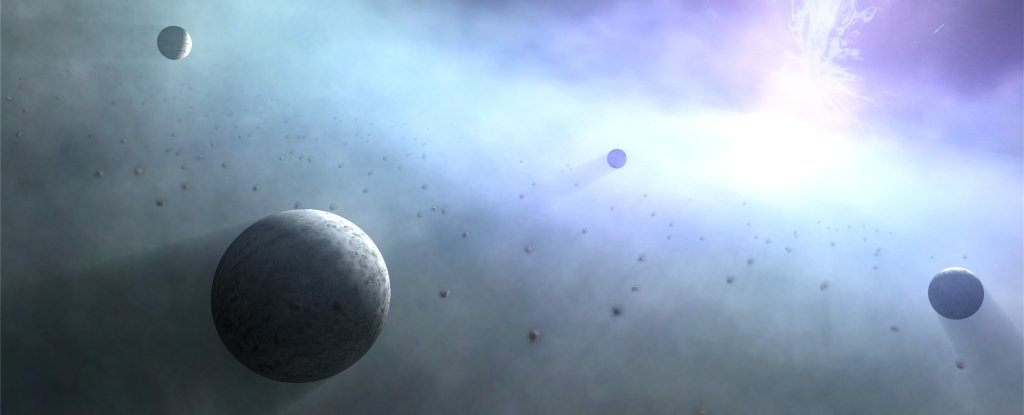Artist's impression of planets orbiting a supermassive black hole. (Kagoshima University)
In the immediate vicinity of a supermassive black hole's event horizon, conditions are pretty wild. But travel a little farther out, and other objects can be snared in its gravitational influence - like the stars orbiting the supermassive black hole at the centre of our galaxy, Sagittarius A*.
According to a new paper, it's not just stars. There could be oodles of planets orbiting supermassive black holes, caught in their gravitational hold, but far out beyond immediate danger - up to tens of light-years away.
Using planetary formation models, a team of astronomers led by Keiichi Wada of Kagoshima University in Japan have shown, for the first time, a new class of planets that can directly form around a black hole.
And these planets would not be subject to the same limitations as planets forming around a baby star.
"Our calculations show that tens of thousands of planets with 10 times the mass of the Earth could be formed around 10 light-years from a black hole," said astronomer Eiichiro Kokubo of the National Astronomical Observatory of Japan.
"Around black holes there might exist planetary systems of astonishing scale."
Like baby stars, black holes can often be surrounded by a large, dense disc of dust and gas. In the case of a star, this rotating disc is left over from the matter that formed the star; out of that protoplanetary disc, planets can then form and continue spinning around their home star.
The fluffy dust aggregate that makes up the disc starts to cling together due to electrostatic forces, then collisions, and then gradually accumulating more and more grains until it's massive enough for gravitational forces to take over, et voilà - after a few million years, you have a planet.
Now, when it comes to supermassive black holes, their discs contain a lot more dust - up to a billion times more than a protoplanetary disc, according to the researchers. Similar planet formation dynamics are likely at play in the outer reaches of the black hole discs as you see in a protoplanetary disc.
It's even possible that black hole discs are, at great distances, more efficient at planet formation than protoplanetary discs. This is because the planet 'seeds' - called planetesimals - wouldn't be subject to a protoplanetary disc phenomenon called the radial drift barrier.
According to dynamical modelling, this occurs when a planetesimal accumulates so much mass that its orbit is no longer stable, and it starts to rapidly migrate towards an accreting star, meeting its eventual demise.
In a disc around a black hole, the radial drift velocity would be negligible compared to the orbital velocity of the rotating disc. The inertia of this orbital velocity would keep the planetesimal from migrating towards the black hole in any meaningful time frame.
Planets also start to form in cooler regions of a protoplanetary disc, where the dust grains are coated with ice. In a disc around an active black hole, blasting radiation from the intense heat generated by the friction of the swirling gas falling into it, the outer regions could be protected from this radiation by the dust itself.
Because the dust is so dense, it would block the radiation, creating cool, planet-formation-safe pockets.
While the researchers' finding is tantalising, sadly we can't currently detect such black-hole-hosted planets. Nevertheless, this research could one day lead to an entire new way of discovering alien worlds - and they might be quite a sight to behold.
The research has been published in The Astrophysical Journal.
